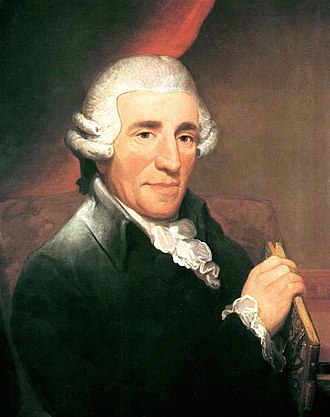
The Symphony No. 48 in C major, Hoboken I/48, is a symphony by Joseph Haydn written in 1768 or 1769. The work has the nickname Maria Theresia as it was long thought to have been composed for a visit by the Holy Roman Empress, Maria Theresa of Austria in 1773. An earlier copy dated 1769 was later found, but the nickname has stuck. The symphony composed for the empress's visit was most likely No. 50.

Symphony No. 50 in C major, Hoboken I/50, by Joseph Haydn was written partly in 1773 and partly in 1774.

The Symphony No. 41 in C major, Hoboken I/41, is a festive symphony by Joseph Haydn. The symphony was composed by 1769. It is scored for flute, two oboes, bassoon, two horns, two trumpets, timpani and strings.

The Symphony No. 38 in C major, Hoboken I/38, is an early and festive symphony by Joseph Haydn. The symphony was composed some time between 1765 and 1769. Because of the virtuosic oboe parts in the final two movements, it has been suggested that the work's composition may have coincided with the employ of the oboist Vittorino Colombazzo in the fall of 1768. The symphony is popularly called the Echo Symphony, a nickname that, like all other named Haydn symphonies, did not originate with the composer.

The Symphony No. 37 in C major, Hob. I/37, is a symphony by Franz Joseph Haydn. The numbering is completely misleading, as it is clearly one of Haydn's earliest symphonies. A copy of the score found at Český Krumlov, Czech Republic, is dated 1758. It can be presumed it was written for the orchestra of Count Morzin, in which Haydn was employed until February 1761.

The Symphony No. 30 in C major, Hoboken I/30, is a symphony by Joseph Haydn composed in 1765, at the age of 33. It is nicknamed the Alleluia Symphony because of Haydn's use of a Gregorian Alleluia chant in the opening movement.

The Symphony No. 33 in C major is a festive symphony by Joseph Haydn. The precise date of composition is unknown. Haydn scholar H.C. Robbins Landon has dated this work to 1763–65. It has also been suggested that it was written in 1760 or 1761, along with Symphony no. 32.

The Symphony No. 25 in C major, Hoboken I/25, is a symphony by Joseph Haydn.The symphony was most likely composed in 1763, or at the very earliest in 1761, at about the same time as No. 33.

The Symphony No. 20 in C major is a festive symphony by Joseph Haydn. Hodgson places the composition date in either 1761 or 1762 while Brown states that it was likely composed before 1761. Calvin Stapert affirmatively states that it was composed in the group of 15 symphonies within Haydns tenure with Count Morzin. And is festive, like C major Symphonies 32, 33, and 37. It is scored for 2 oboes, bassoon, 2 horns, 2 trumpets, timpani, strings and continuo. The symphony is in four movements:
- Allegro molto, 2
4 - Andante cantabile, 2
2 in G major - Minuetto & Trio, F major 3
4 - Presto, 3
8

Joseph Haydn's Symphony No. 27 in G major was probably written before March 19, 1761, while he was employed by Count Morzin. Its chronological position was assigned by Eusebius Mandyczewski in 1907. Although later adopted by Hoboken, Robbins Landon has subsequently revised the work's likely chronological position and now believes that the symphony is one of Haydn's earliest, written at roughly the same time as symphonies nos. 15–18. Haydn himself may have labeled the symphony his 16th, although this remains unclear.

Joseph Haydn's Symphony No. 1 in D major, Hoboken I/1, was written in 1759 in Dolní Lukavice, while in the service of Count Morzin. Though identified by Haydn as his first symphony, scholars are not sure if it is actually the first he composed, or even the first that survived to posterity. While it is reliably known that No. 1 was written in 1759, H. C. Robbins Landon cannot rule out that No. 2,No. 4, or both could have been composed in 1757 or 1758.

Joseph Haydn's Symphony No. 2 in C major, Hoboken I/2, is believed to have been written between 1757 and 1761.

Joseph Haydn's Symphony No. 4 in D major, Hoboken I/4, is believed to have been written between 1757 and 1761.

Joseph Haydn's Symphony No. 14 in A major, Hoboken I/14, may have been written between 1761 and 1763.

Joseph Haydn's Symphony No. 17 in F major, Hoboken I/17, may have been written between 1757 and 1763.

The Symphony No. 10 in D major, Hoboken I/10, is a symphony by Joseph Haydn. The symphony may have been written as early as 1757 but no later than 1761, probably for the small, but resourceful orchestra of Count Morzin.

The Symphony No. 18 in G major, Hoboken I/18, is a symphony by Joseph Haydn. The composition date is conspicuously uncertain. The Breitkopf catalogue entry assures that it was composed no later than March 1766, the date of the Esterhazy orchestra moving to Esterhaza, but most scholars believe it was composed at least a few years before then. Dates between 1757 and 1764 have been also suggested but not proven.

The Symphony No. 19 in D major, Hoboken I/19, is a symphony by Joseph Haydn. The symphony was composed between 1757 and 1761.

Joseph Haydn's Symphony 'A' in B♭ major, Hoboken I/107, was written between 1757 and 1760. It therefore must have been composed for Count Morzin's orchestra, for whom Haydn worked until 1761.


